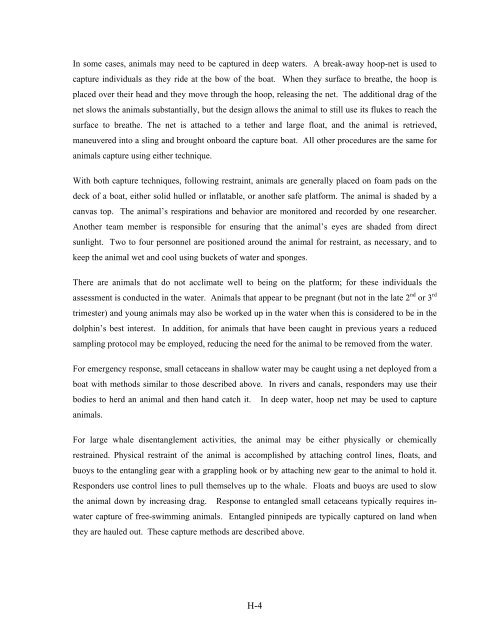Volume III, Appendices EM - National Marine Fisheries Service ...
Volume III, Appendices EM - National Marine Fisheries Service ...
Volume III, Appendices EM - National Marine Fisheries Service ...
Create successful ePaper yourself
Turn your PDF publications into a flip-book with our unique Google optimized e-Paper software.
In some cases, animals may need to be captured in deep waters. A break-away hoop-net is used to<br />
capture individuals as they ride at the bow of the boat. When they surface to breathe, the hoop is<br />
placed over their head and they move through the hoop, releasing the net. The additional drag of the<br />
net slows the animals substantially, but the design allows the animal to still use its flukes to reach the<br />
surface to breathe. The net is attached to a tether and large float, and the animal is retrieved,<br />
maneuvered into a sling and brought onboard the capture boat. All other procedures are the same for<br />
animals capture using either technique.<br />
With both capture techniques, following restraint, animals are generally placed on foam pads on the<br />
deck of a boat, either solid hulled or inflatable, or another safe platform. The animal is shaded by a<br />
canvas top. The animal’s respirations and behavior are monitored and recorded by one researcher.<br />
Another team member is responsible for ensuring that the animal’s eyes are shaded from direct<br />
sunlight. Two to four personnel are positioned around the animal for restraint, as necessary, and to<br />
keep the animal wet and cool using buckets of water and sponges.<br />
There are animals that do not acclimate well to being on the platform; for these individuals the<br />
assessment is conducted in the water. Animals that appear to be pregnant (but not in the late 2 nd or 3 rd<br />
trimester) and young animals may also be worked up in the water when this is considered to be in the<br />
dolphin’s best interest. In addition, for animals that have been caught in previous years a reduced<br />
sampling protocol may be employed, reducing the need for the animal to be removed from the water.<br />
For emergency response, small cetaceans in shallow water may be caught using a net deployed from a<br />
boat with methods similar to those described above. In rivers and canals, responders may use their<br />
bodies to herd an animal and then hand catch it. In deep water, hoop net may be used to capture<br />
animals.<br />
For large whale disentanglement activities, the animal may be either physically or chemically<br />
restrained. Physical restraint of the animal is accomplished by attaching control lines, floats, and<br />
buoys to the entangling gear with a grappling hook or by attaching new gear to the animal to hold it.<br />
Responders use control lines to pull themselves up to the whale. Floats and buoys are used to slow<br />
the animal down by increasing drag. Response to entangled small cetaceans typically requires inwater<br />
capture of free-swimming animals. Entangled pinnipeds are typically captured on land when<br />
they are hauled out. These capture methods are described above.<br />
H-4
















